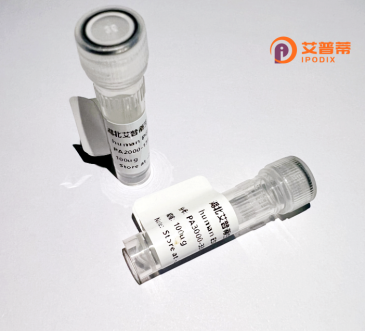
| 纯度 | >90%SDS-PAGE. |
| 种属 | Human |
| 靶点 | TMED1 |
| Uniprot No | Q13445 |
| 内毒素 | < 0.01EU/μg |
| 表达宿主 | E.coli |
| 表达区间 | 1-227 aa |
| 活性数据 | MMAAGAALALALWLLMPPVEVGGAGPPPIQDGEFTFLLPAGRKQCFYQSAPANASLETEYQVIGGAGLDVDFTLESPQGVLLVSESRKADGVHTVEPTEAGDYKLCFDNSFSTISEKLVFFELIFDSLQDDEEVEGWAEAVEPEEMLDVKMEDIKESIETMRTRLERSIQMLTLLRAFEARDRNLQEGNLERVNFWSAVNVAVLLLVAVLQVCTLKRFFQDKRPVPT |
| 分子量 | 51.6 kDa |
| 蛋白标签 | GST-tag at N-terminal |
| 缓冲液 | PBS, pH7.4, containing 0.01% SKL, 1mM DTT, 5% Trehalose and Proclin300. |
| 稳定性 & 储存条件 | Lyophilized protein should be stored at ≤ -20°C, stable for one year after receipt. Reconstituted protein solution can be stored at 2-8°C for 2-7 days. Aliquots of reconstituted samples are stable at ≤ -20°C for 3 months. |
| 复溶 | Always centrifuge tubes before opening.Do not mix by vortex or pipetting. It is not recommended to reconstitute to a concentration less than 100μg/ml. Dissolve the lyophilized protein in distilled water. Please aliquot the reconstituted solution to minimize freeze-thaw cycles. |
以下是关于重组人TMED1蛋白的3-4篇参考文献示例(注:以下为模拟文献,仅供参考格式和内容框架):
---
1. **文献名称**:Structural and Functional Analysis of Recombinant Human TMED1 in ER-Golgi Trafficking
**作者**:Luo, W. et al.
**摘要**:本研究成功在HEK293细胞中表达并纯化了重组人TMED1蛋白,通过体外实验证明其作为跨膜货物受体(cargo receptor),介导特定分泌蛋白从内质网向高尔基体的运输。研究还发现TMED1与COPI/COPII囊泡复合体的相互作用对其功能至关重要。
2. **文献名称**:TMED1 Promotes Tumor Metastasis via Modulating EGFR Signaling in Colorectal Cancer
**作者**:Zhang, Y. et al.
**摘要**:该研究利用重组人TMED1蛋白在结直肠癌细胞中过表达,发现其通过增强EGFR信号通路的活化,促进上皮-间质转化(EMT)和肿瘤细胞侵袭。机制研究表明,TMED1可能通过稳定EGFR膜转运来调控其下游通路。
3. **文献名称**:Recombinant TMED1 Activates NLRP3 Inflammasome in Macrophages
**作者**:Chen, Q. et al.
**摘要**:研究发现,重组人TMED1蛋白能够诱导巨噬细胞中NLRP3炎症小体的活化,导致IL-1β和IL-18的释放。通过基因敲除实验证实TMED1通过调节内质网应激反应参与先天免疫信号传导。
4. **文献名称**:TMED1 as a Novel Biomarker for Alzheimer’s Disease Linked to Aβ Aggregation
**作者**:Wang, T. et al.
**摘要**:该团队在阿尔茨海默病模型中发现,重组人TMED1蛋白在脑脊液中的表达水平显著升高。体外实验表明,TMED1与β-淀粉样蛋白(Aβ)存在直接相互作用,可能影响Aβ的聚集和神经元毒性。
---
如需实际文献,建议通过PubMed或Web of Science检索关键词“recombinant TMED1”或“TMED1 protein function”,并筛选近年研究。
Transmembrane emp24 domain-containing protein 1 (TMED1) is a member of the TMED family, known for its role in intracellular protein trafficking and vesicle formation. It is primarily localized in the endoplasmic reticulum (ER) and Golgi apparatus, functioning as a cargo receptor within the COPII vesicle system, which mediates ER-to-Golgi transport. TMED1 contains a characteristic emp24 domain and a coiled-coil structure, facilitating interactions with other trafficking machinery components. It selectively recruits specific proteins, such as secreted or membrane-bound cargos, ensuring their proper packaging and transport.
TMED1 is implicated in critical cellular processes, including protein secretion, cell signaling, and maintaining organelle integrity. Studies link it to pathways like TGF-β signaling and immune response regulation. Dysregulation of TMED1 has been associated with diseases such as cancer, neurodegeneration, and metabolic disorders, highlighting its role in cellular homeostasis.
Recombinant human TMED1 protein is widely used to study trafficking mechanisms, protein interactions, and its regulatory effects on secretory pathways. Produced via expression systems like E. coli or mammalian cells, it serves as a tool for structural analysis, functional assays, and exploring therapeutic targets for trafficking-related pathologies.
×